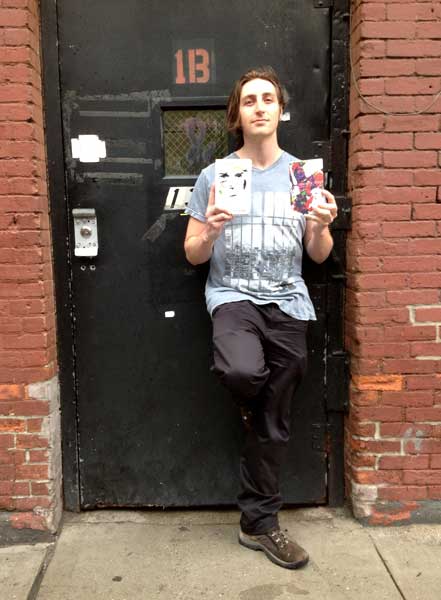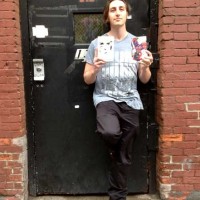
Buying a book is an experience from the moment you walk in the book store, flip through the pages and read the back cover, to the time you miss a subway stop because you can’t put it down. Nathaniel Kressen considered this experience in creating Concrete Fever, his debut novel. Not only did he compose an exciting story, but he took intricate care in printing the physical product. I sat down with him to talk about his process on all fronts.
First, I wanted to ask you about the production of Concrete Fever because it’s pretty unusual. The first edition which is hand-made has been on the market for a while. Why did you decide to do a second edition?
For a lot of reasons. One was we wanted to expand Concrete Fever’s reach. It was in three stores in Brooklyn, and we got a really good response out of those three stores but kept hitting a wall when we wanted to do readings…we never had more copies! With the paperback edition we can get all the same artistic fulfillment, but still get it out to more readers.
So tell me about the process of making the first edition. I know it’s done by hand, so it would be cool to know just what went behind that.
To source the paper I went to a weird alcove-warehouse in the middle of the Brooklyn Navy Yard. You go through paper swatches like you do with paint swatches. I walked out of there spending a lot more money than I intended, because it turns out I’m a paper nerd. After that I formatted it and just printed it out on a laser-jet printer and sliced the pages. There’s actually a whole community of bookbinders in Brooklyn. There’s a supply center called Talas in Bushwick that has all the bookbinding stuff you could ever want, so I got all these wonderfully weird items like an awl which looks like a murder weapon.
Cool.
Yeah, it’s like a wood ball with a sharp spike at the end of it. In the first days that we bound this book, it took me about 6 hours. Now it’s about an hour and a half per copy.
How did you get so many copies done?
In the early days we would have bookbinding parties where we’d invite a lot friends, buy them pizza and beer, and form an assembly line. After all that I went on to teach bookbinding workshops at Better Than Jam and WORD.
Independent publishing is big right now. Why did you decide to go that route?
It was about creative control. When you go through a big publisher, you have a lot of manpower behind you–people pitching, promoting, but they don’t always embrace what it’s actually about.
Also there’s a real joy in being completely responsible over your own product. And your work should be that–it should be a product. You should want people to hold it in their hands and get excited about what’s inside. My wife and I collaborated so long on this piece we couldn’t wait to get it out to people and see their responses.
Another thing. Musicians and visual artists have been doing this for years. They’ve been putting out their first album and then get picked up by a bigger company. There’s a stigma about self-published authors, but really this has been going on a long time in other industries.
The actual images in Concrete Fever are beautiful. How did you go about creating them?
The way my wife works as an illustrator is to have people play out scenes, so we brought on two actors we’re friends with, and the male actor has played Jumper since the story first started as a stage play. We paired him up with an actress we’ve also worked with a lot and took a photoshoot in Greenpoint on a stairwell and a rooftop. So my wife sat down for the next few months and did ink drawings from the photographs. Eight of those ended up in the book.
What about the cover?
As for the cover of the second edition, I’m lucky enough to be married to my illustrator, so we had a lot of drunken and late night conversations about the direction we wanted to go in. We went through the same process, except this time I ended up being the subject for the photos. It all came together in this wonderfully-weird circumstance where I got a black eye playing basketball, and when you read the novel Jumper gets hurt all throughout the course of the night. The new image we wanted was of Jumper falling or lying on the ground, so I ended up lying in the snow in a three piece suit, and she took photos of me beat to all hell in the suburbs of New Jersey.
Haha. Sounds like a fun night. So you say this started out as a play. How did it transition into a full-on novel?
We did the original production of the play in 2007 at Walker Space in SoHo. About 4 years later I was reading a lot – Gabriel Garcia Marquez, Cormac McCarthy, Collum McCann, just tons of fiction – and for a while after writing the play, I was obsessed with the idea of a young kid who’s living in the city at the time of 9/11, and whose world gets turned upside down. I read a lot to learn more about the types of structure a novel can take, since I went to school as an actor and not a writer, and while I was researching those voices, the material from the play came back to me, and combined with the new idea for what would become Concrete Fever.
The novel itself bounces back and forth between the budding relationship of Jumper and Gypsy, and then of Jumper’s father and mother that draw a lot of parallels. Is this technique common in your work?
This kind of surprised me. I don’t normally write things that shoot back and forth with parallel story lines. Jumper’s father and mother are called Nix and Jughead. I started writing Nix and Jughead merely as a backstory for Jumper, but something kept nagging me, so I kept going. The way it ended up playing is that Jumper and Gypsy mirror a younger Nix and Jughead. It shows what could happen if they let their bad impulses get the better for them. If they repeat the sins of their parents they’ll fall apart. If they create something new, they’ll move forward.
So are parent/ child relationships a source of meaning for your writing?
I think we’re all very tied to the people who raised us. Jumper and Gypsy are at an age where they don’t see how closely their personality and judgments mirror their parents. I think only in the last couple years did I realize how much parents are just people who happened to have kids. I tried to face that with this book.
Concrete Fever takes place in Manhattan, but you’ve been a Brooklynite for years. What drew you to write about Manhattan?
When I’m in Manhattan I’m constantly searching for something that makes being in that amount of traffic and chaos worth it. In Brooklyn things are slower and you kind of feel embraced. I wanted to show these two kids are flitting from neighborhood to neighborhood, searching for some sense of magic or the unknown, and then uncovering it from time to time but still feeling grossly unfulfilled. I wanted to show the chase that I felt when I was younger, searching for that moment, and I wanted to see it exist in the book.
Your writing, short stories that I’ve read too, seems very city based. Are urban landscapes your preferred setting?
I went through a period where I was really interested in all the tiny stories that never get written about in this city. There’s people piled on top of people here. Any one of them has a thousand stories that could be written about their lives.
But more recently I’ve been into this idea of an open space where someone could be approaching you in a desolate area, and you don’t know if they could pose a threat to you since you’re the only two around. So now my second novel is set on a farmhouse in Idaho where nothing will grow. It follows two abandoned kids who have no one but each other to turn to.
And obviously because I have to ask–what books are you into right now? If I had to get anything on my shelf this second, what would it be?
I always recommend Nog by Rudoloph Wurlitzer. 100 Years of Solitude by Gabriel Garcia Marquez too.
Concrete Fever will be officially released on June 6, but is already available in certain stores.
Follow Vol. 1 Brooklyn on Twitter, Facebook, Google +, our Tumblr, and sign up for our mailing list.

